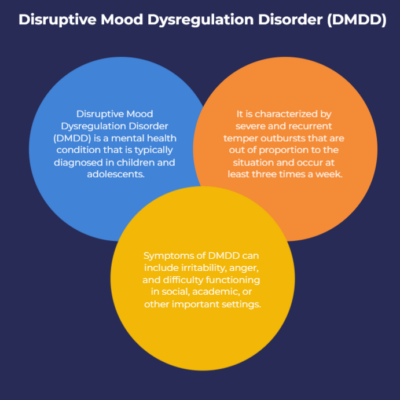What is Disruptive Mood Dysregulation Disorder?

Disruptive Mood Dysregulation Disorder (DMDD) is a childhood condition in which young and adolescent children experience ongoing irritability, anger, and display inappropriate and recurrent temper outbursts that happens multiple times per week. The symptoms are quite severe, leading to issues at home and at school – friend and family relationships are disrupted, and school performance may decline.
“All children can become irritable sometimes.” In fact, irritability is a normal feeling when we’re stressed or frustrated. So, what is the difference between normal irritability and severe irritability? - Children with DMDD have a hard time tolerating frustrating scenarios and have significantly out-of-proportion outbursts to these situations that aren’t expected for their age. Most parents would see these as indicating the child is out of control.
For example:
A child without DMDD, whose parent tells them its “time to come off TikTok and put down the phone” may get annoyed, frustrated, or pout. On the other hand, a child with DMDD may get extremely emotional, and have temper outburst with yelling and hitting.
Signs & Symptoms
Children with DMDD exhibit:
- Outbursts and tantrums that have been ongoing for at least 1 year
- Severe verbal or behavioural temper outbursts most days of the week
- Irritable or angry mood most of the day
- Trouble functioning due to irritability
Studies have shown that patients with disruptive mood dysregulation disorder in childhood have a high risk of progressing to depressive disorders and anxiety disorders over time.
Diagnosis
Children with DMDD may first be diagnosed when they’re between the ages of 6 and 10, and the diagnosis is only applicable up to the age of 18. This diagnosis may be given by a physician or mental health professional who has experience working with children and adolescents.
Can DMDD be treated?
Yes. Current treatments are primarily based on research focused on other childhood disorders associated with irritability like anxiety and ADHD. Many of these treatments have been shown to work for DMDD. So, treatment for DMDD generally includes certain types of psychotherapy (“talk therapy”) and sometimes medications.
References
- American Psychiatric Association. (2013). Diagnostic and statistical manual of mental disorders: Dsm-5.
- Black , D. W., & Andreasen , N. C. (2013). Introductory Textbook Of Psychiatry (6th ed.). American Psychiatric Publishing.
- Boland, R. J., Verduin, M. L., Ruiz, P., Shah, A., & Sadock, B. J. (2022). Kaplan & Sadock’s Synopsis of Psychiatry. Wolters Kluwer.
- U.S. Department of Health and Human Services. (n.d.). Disruptive mood dysregulation disorder: The basics. National Institute of Mental Health. Retrieved December 12, 2022, from
- https://www.nimh.nih.gov/health/publications/disruptive-mood-dysregulation-disorder
